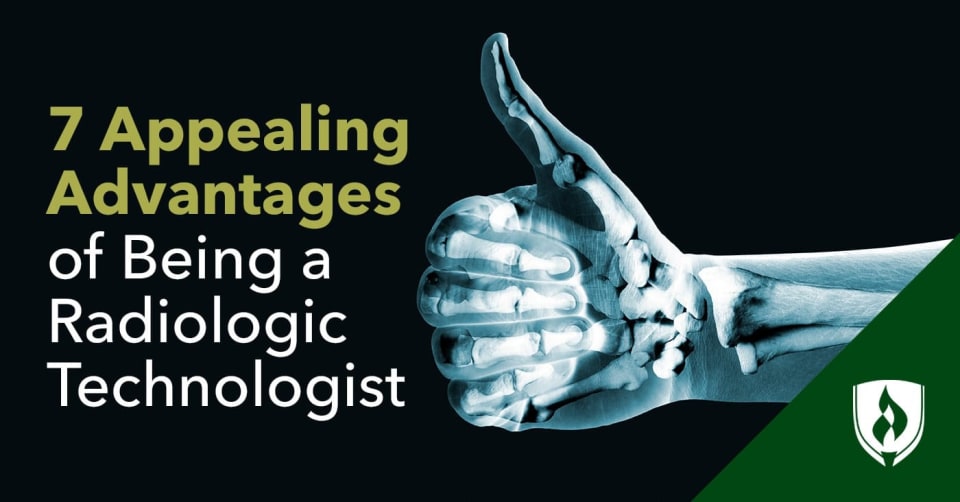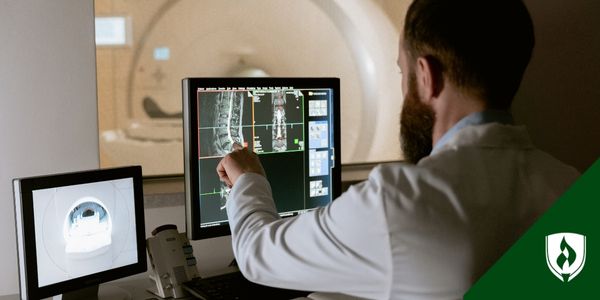
You know it’s well past time to make a change in your career. You’re done with boring, dead-end jobs. You want something more—a career you can feel good about. One that helps support your family. And something with a few additional perks doesn’t hurt either.
If you’re looking for a way to combine your love of technology with your passion for helping others, consider becoming a radiologic technologist. Spend your days operating high-tech machinery to help doctors discover lifesaving solutions for their patients.
If you’re ready to upgrade your ordinary job for an extraordinary career, you’ve come to the right place. Read ahead to check out the enticing benefits of being a radiologic technologist—and see whether they sound like something you might appreciate. But first, let’s take a quick look at what the role entails.
What does a radiologic technologist do?
Before we get into the advantages of the job, it’s important to have a good understanding of what a radiologic technologist actually does. If you’ve ever broken a bone or had an ultrasound, you were likely assisted by one of these friendly medical specialists.
Sometimes known as radiographers, these professionals use X-rays, sound waves and other diagnostic imagery to create images of bones, internal organs and tissue. They operate state-of-the-art technology in order to capture images that help radiologists diagnose patients.1
Most radiologic technologists are trained in X-ray and computed tomography (CT) imaging. But some choose to focus on a specialized area such as mammography or magnetic resonance imaging (MRI).
7 Enticing benefits of being a radiologic technologist
Now you know about the basic duties of a radiologic technologist. It’s clear that patients benefit from the work of these medical professionals, but they’re also reaping the rewards that come with being a radiologic technologist.
Learn more about these seven advantages radiologic technologists enjoy on the job.
1. Say goodbye to boring routines
Don’t go through life counting down the hours until the workday is done. If you’re stuck in a boring job now, the variety in a radiologic technologist’s day is sure to appeal to you.
While radiologic technologists do have specific duties they perform on the job each day, the nature of the healthcare setting offers plenty of variety and excitement from one shift to the next. Their days are full of assisting different patients with different diagnostic imaging needs, leaving little chance to get bored.
Radiologic technologists can also gain cross-training experience within the medical setting and go on to pursue specializations in other types of imaging technology, such as MRIs or tomography. The opportunity to continually expand your skills is sure to stave off any on-the-job boredom.
2. Escape the 9-to-5 corporate crunch
Some people love their steady 9-to-5 job—others can’t stand it. Sitting in a cubicle all day isn’t for everyone. Escape the rat race and restrictive office culture by finding solace in the healthcare field as a radiologic technologist.
Working in healthcare offers plenty of benefits over a traditional 9-to-5 office job. Trade in your button-ups and dress shoes for comfortable scrubs. And forget about the constant pressure to compete with your coworkers for the next promotion.
And then there are the work hours themselves. Healthcare isn’t an industry that shuts off the lights each night—or on holidays and weekends, for that matter. If a flexible schedule appeals to you, this is a definite advantage to being a radiologic technologist.
3. You can work in a variety of settings
One of the major perks of being a radiologic technologist is that work opportunities aren’t typically tied to a small geographic area. You’re not even tied to major metropolitan areas. According to the Bureau of Labor Statistics (BLS), most radiologic technologists work in hospitals, and lucky for you, hospitals and their trusted employees are needed everywhere.1
You’ve got other options even if the hospital environment doesn’t appeal to you. Radiologic technologists can also find employment in clinics, diagnostic labs and outpatient care centers.1
4. Employment opportunities are increasing
The fact that radiologic technologists are needed in all geographic areas is a plus. But what’s even more promising is that more job opportunities are expected to open in the years to come. The BLS projects radiologic technologist positions to increase 9 percent from 2020 through 2030.1 This is slightly faster than the 8 percent growth projected nationally for all occupations.
The BLS attributes part of this growth to the aging baby-boomer population, which will cause an increase in medical conditions that rely on diagnostic imaging. Radiologic technologists who graduate from an accredited program and obtain certifications will have the best job prospects, according to the BLS.1
5. You don’t have to spend several years in school
All healthcare careers require tons of education, right? Wrong! Radiologic technologists reap the benefits of a healthcare career without spending several years of time (and tuition) in school.2
According to the BLS, most radiologic technologists earn an associate degree before entering the field.1 You could earn your Radiologic Technology degree in as few as 24 months.2 Your education will likely include clinical experience in addition to classroom training, and you may have the option to become certified (though not all states require this). Either way, you could be just two years away from launching the rewarding healthcare career you have your sights set on.2
6. You'll work with a diverse range of patients
As a radiologic technologist, you’ll have the skills to help patients of all ages, from all walks of life.X-rays and CT scans are essential diagnostic tools used to treat everyone from injured athletes to accident victims and cancer patients. And, as the number of falls and cancer cases increase, there will continue to be a need for professionals in this line of work, according to the BLS.1
7. It’s a career you can feel good about
Perhaps the best advantage of being a radiologic technologist is that it’s something you can feel proud of at the end of each day. Not only are you working face-to-face with patients, ensuring they are comfortable and receiving the help they need, but you’re a critical player in the healthcare team as a whole.
You’re working in the ranks of a highly honored and respected field. The bottom line is that being a radiologic technologist is incredibly rewarding.
Ready to become a radiologic technologist?
Don’t sit idle and let another opportunity pass you by. It’s time to trade in the mundane job you tolerate for a meaningful career you’ll be proud of!
Whether it’s the flexibility, the variety or the earning potential that catch your attention, it’s time to start reaping the rewards of being a radiologic technologist. Learn more about the road ahead in our article “How to Become an X-Ray Tech: A Step-by-Step Guide.”
Related Articles:
- Radiologist vs. Radiologic Technologist: Illuminating the Differences
- Examining 5 Commonly Confused Radiology Careers
- What Healthcare Workers Need to Know About Radiation Effects
1Bureau of Labor Statistics, U.S. Department of Labor, Occupational Outlook Handbook, [information accessed June, 2022] www.bls.gov/ooh/. Information represents national, averaged data for the occupations listed and includes workers at all levels of education and experience. Employment conditions in your area may vary.
2Completion time is dependent on the number of courses completed each term.
EDITOR’S NOTE: This article was originally published in August 2016. It has since been updated to include information relevant to 2022.




